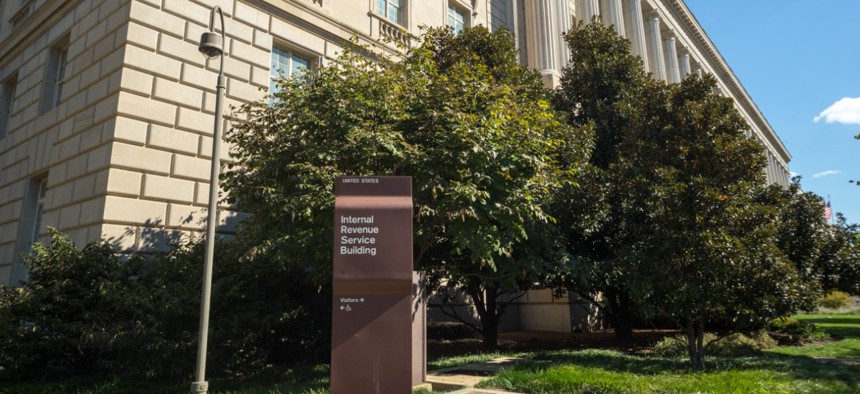IRS Is Letting Some of the Highest-Income Americans Get Away Without Paying Taxes
Hundreds of thousands of high-income Americans are not filing taxes with impunity, despite collectively owing $46 billion over three years.
Uncle Sam is struggling to collect taxes from the highest-earning Americans who decline to voluntarily file them, according to a new investigation, which found those individuals collectively owed nearly $46 billion over a recent three-year period.
While high-income individuals make up a small portion of non-filers every year, the Treasury Inspector General for Tax Administration found they owe a majority of the tax debt from that population. The Internal Revenue Service is struggling to address the high-income population due to a lack of prioritization and a significant reduction in staffing, the watchdog found. The agency lost about one-fifth of its collection workforce, or about 2,000 employees, between fiscal years 2013 and 2018.
In fiscal years 2014 through 2016, about 879,000 high-income Americans did not file taxes. The IRS did not “work”—meaning it did not assign a revenue officer to the case or otherwise launch an investigation and seek payment—or even place the cases in the inventory for possible investigation in 369,000 instances. Those individuals maintain outstanding tax debt of nearly $21 billion. In 43,000 cases, IRS closed out the cases without taking any steps to address the noncompliance. TIGTA identified 50,000 high-income individuals who did not file taxes in any of the three years, who collectively owe the government $7 billion.
TIGTA suggested IRS should go after high-income earners who decline to file taxes not just for efficient revenue generation but also for ethical reasons.
“Intentional non-filing of tax returns by those with significant financial resources and sophistication is a brazen form of noncompliance,” the IG said, adding the agency was defying its own procedures. “According to IRS procedures, high-income non-filer cases present a high compliance risk; therefore, these should typically be selected for review and issued a notice.”
In the same three fiscal years, the highest earners who did not pay their taxes—those who make up less than 1% of the high-income non-filers—represented more than one-third of the tax debt the group as a whole owes. The top 100 highest-earning individuals in each of the three years collectively owe $10 billion. In 99 of those 300 cases, the IRS did not even place the case into the investigation inventory and 44 were closed without any effort to work them. The remaining 157 cases were technically in the queue, but IRS conceded it was unlikely to work them due to a decline in available resources.
TIGTA identified those individuals to IRS and recommended the agency target them for payment, though management did not indicate whether it would follow that advice. IRS agreed with the IG to create a team to focus on high-income non-filers, but suggested it must take a balanced approach with its other compliance programs. The agency said it would not, as the IG recommended, identify a senior official to oversee non-filer cases.
“Enhancements are needed in resource allocation to ensure that the most egregious non-filers are pursued systematically,” the investigators wrote. “If high-income taxpayers believe the IRS’ effort in this area is temporary or intermittent, it is unlikely to have a long-term benefit on voluntary tax compliance.”
The IG also noted the rapid decline in staffing has negatively impacted IRS’ ability to fulfill its mission to collect taxes.
“The impact of the declining staff resources is that fewer delinquency notices are being issued, resulting in fewer non-filer cases being started,” TIGTA wrote. “This causes lower non-filer inventory levels and ultimately decreases revenue collected from nonfiler casework.”
The investigators recommended IRS consider all years non-filers declined to pay taxes, rather than working cases one year at a time. Doing so, they said, would enable the agency to focus on higher-priority cases leading to more revenue coming in. They noted if a non-filer does not pay, his or her case is ultimately placed into a “uncollectable inventory.”
“It is concerning that high-income non-filers, which are high-priority cases, are being shelved,” TIGTA said. “By shelving high-income non-filer cases, the IRS may miss opportunities to bring these taxpayers back into compliance, resulting in the potential loss of billions of dollars in revenue.”
The number of non-filers across the country has ticked up in recent years. About 7 million Americans failed to file taxes in fiscal years 2010 through 2013, but that has since steadily increased to more than 10 million in fiscal 2016. The IRS used to pursue most non-filer cases, TIGTA said.
The IRS in 2018 established a new strategy for handling non-filing cases, though TIGTA said it has largely not been implemented and questioned how effective it will be. IRS said it will identify and prioritize cases to maximize revenue and encourage voluntary filing, engage in more testing and learning on the most effective collection techniques and implement more analytics to gain insight for deploying resources.








